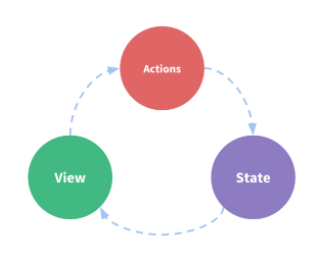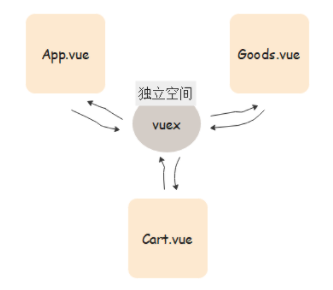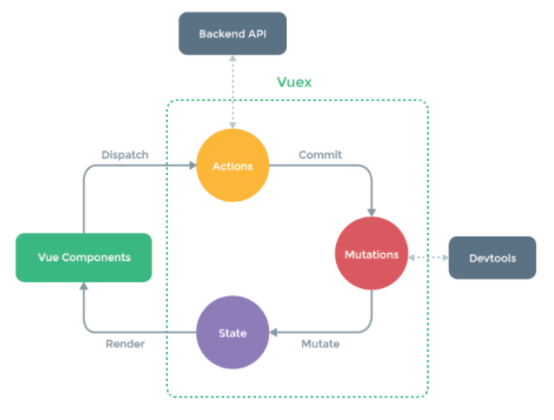Vuex 是一个专门为 Vue.js 应用程序开发的状态管理模式。
1 状态管理模式
1.1 单向数据流

1.2 多组件共享时【多组件间的数据通讯:切换-生命周期的销毁】
-
多个视图依赖于一个状态
-
来自不同视图的行为需要变更同一个状态

1.3 通过定义和隔离状态管理中的各种概念并通过强制规则维持视图和状态间的独立性
2 store仓库
每个 vuex 应用的核心就是
store。store基本上就是一个容器,它包含着应用中大部分的状态(state)
2.1 vuex 和单纯的全局对象有以下两点不同:
-
vuex 的状态存储是响应式的。
-
不能直接改变 store 中的状态。
2.2 实例化一个 store -- 一个应用只运行有一个 store
- 引入 vuex
import Vue from 'vue';
import Vuex from 'vuex';
- 使用(安装)vuex
Vue.use(Vuex);
- 实例化 store
const store = new Vuex.Store({
state: {
goodsList: [{
id: '',
name: '',
price: '',
qty: ''
}]
},
getters: {
totalPrice(state) {
return state.goodsList.reduce((prev, item)=> prev+item.price*item.qty, 0)
}
},
mutations: {
removeFromCart(state, id) {
state.goodsList=state.goodsList.filter(item=>item.id!=id)
},
clearCart(state) {
state.goodsList=[]
},
addCart(state, goods) {
state.goodsList.unshift(goods)
},
changeQty(state, payload) {
state.goodsList.forEach(item=>{
if(item.id == payload.id) {
item.qty = payload.qty
}
})
}
},
actions: {
async changeQtyAsync(context, {id, qty}) {
let {data} = await
if(qty > data) qty = data
context.commit('changeQty', {id, qty})
}
}
})
- 把 store 注入到 vue 实例
new Vue({
el: '#app',
router,
store
});
- 在组件中使用数据
this.$store
3 Store 存储空间--仓库
3.1 store
-
state-- 真正存放数据的位置 -- 类似于组件中的data -
getter-- 类似于组件中的computed -
mutations-- 修改state的方法 -- 类似于组件中的methods -
actions-- 异步修改state的方法 -- 不能直接修改

3.2 state
通过在根实例注册 store 选项,该 store 实例会注入到根组件下的所有子组件中,且子组件能够通过
this.$store访问到。
1. 操作 state
-
获取 state:
this.$store.state.xxx -
修改 state:
this.$store.commit(mutation)
2. mapState 辅助函数【映射到 computed 】
当一个组件需要获得多个状态时,将这些状态都声明为计算属性会有些复杂和冗余。
- 使用
mapState辅助函数自动生成计算属性。
import {mapState} from 'vuex'
export default {
computed: mapState({
count: state => state.count,
countAlias: 'count', // 等同于 state => state.count
countPlusLocalState(state) {
return state.count+this.localCount
}
})
}
- 当映射的计算属性的名称与 state 的子节点的名称相同时,可以给
mapState传一个字符串数组。
computed: mapState(['count']) // this.count=store.state.count
3. 对象展开运算符
- 通过对象展开运算符,可以将
mapState函数返回的对象与局部计算属性混合使用。
computed: {
localComputed() { },
...mapState({})
}
4. 组件仍然保有局部状态
3.3 Getter
vuex 允许我们在 store 中定义
getter。就像计算属性一样,getter的返回值会根据它的依赖被缓存起来,且只有当它的依赖发生了改变才会被重新计算。
- Getter 接收
state作为其第一个参数。
const store = new Vuex.Store({
state: {
todos: [
{id: 1, text: '...', done: true},
{id: 2, text: '...', done: false}
]
},
getters: {
doneTodos: state=> {
return state.todos.filters(todo=>todo.done)
}
}
})
- Getter 也接受其他 getter 作为第二个参数。
getters: {
doneTodosCount: (state, getters) {
return getters.doneTodos.length
}
}
- getter 在通过属性访问时是作为 vue 的响应式系统的一部分缓存其中的。
1. mapGetters 辅助函数
mapGetters辅助函数仅仅是将 store 中的 getter 映射到局部计算属性。
import {mapGetters} from 'vuex'
export default {
computed: {
...mapGetters(['doneTodosCount','anotherGetter'])
}
}
- 使用对象形式,给一个 getter 属性另取一个名字
...mapGetters({
doneCount: 'doneTodosCount'
// doneCount: this.$store.getter.doneTodosCount
})
3.4 Mutation
-
更改 vuex 中 store 的状态的唯一方法就是提交
mutation。 -
vuex 中的
mutation类似于事件:每个mutation都有一个事件类型 type + 回调函数 handler。这个回调函数就是我们实际进行状态更改的地方,并且它会接收 state 作为第一个参数。
const store = new Vuex.Store({
state: {
count: 1
},
mutations: {
increment(state) {
state.count++
}
}
})
// 调用mutation handler
this.$store.commit('increment')
1. 提交载荷
- 可以向
store.commit传入额外的参数,即mutation的载荷payload。
mutations: {
increment(state,n) {
state.count += n
}
}
// 调用
this.$store.commit('increment', 10)
- 多数情况下,载荷应该是一个对象,这样可以包含多个字段并且记录的
mutation会更易读。
mutations: {
increment(state, payload) {
state.count += payload.amount
}
}
// 调用
this.$store.commit('increment', {amount: 10})
2. 对象风格的提交方式
- 提交
mutation的另一种方式是直接使用包含 type 属性的对象。当使用对象风格的提交方式,整个对象都作为载荷传给mutation函数,因此 handler 保持不变。
this.$store.commit({type:'increment', amount: 10})
3. Mutation 必须是同步函数
-
每一条
mutation被记录,devtools都需要捕捉到前一状态和后一状态的快照。 -
任何在回调函数中进行的状态的改变都是不可追踪的。
mutations: {
someMutation(state) {
api.callAsyncMethod(()=>{state.count++})
}
}
4. 在组件中提交 Mutation
-
可以在组件中使用
this.$store.commit('xxx')提交mutation。 -
可以使用
mapMutations辅助函数将组件中的methods映射为store.commit调用。
import {mapMutation} from 'vuex'
export default {
methods: {
...mapMutations(['increment','incrementBy']),
...mapMutations({add: 'increment'}),
...mapMutations({
changeQty2: (commit,payload)=> {
commit('changeQty',payload)
}
})
}
}
3.5 Action
-
Action类似于mutation,不同在于:-
Action提交的是mutation,而不是直接变更状态。 -
Action可以包含任何异步操作。
-
const store = new Vuex.Store({
state: {
count: 0
},
mutations: {
increment(state) {
state.count++
}
},
actions: {
incrtement(context) {
context.commit('increment')
}
}
})
-
Action函数接受一个与store实例具有相同方法和属性的context对象。 -
可以调用
context.commit提交一个mutation,或者通过context.state和context.getters来获取 state 和 getters 。
actions: {
increment({commit}) {
commit('increment')
}
}
1. 分发 Actions
Actions通过store.dispatch方法触发。
actions: {
incrementAsync({commit}) {
setTimeout(()=> commit('increment'), 1000)
}
}
this.$store.dispatch('incrementAsync')
Actions同样支持的载荷方式和对象方式进行发布。
this.$store.dispatch('incrementAsync', {amount: 10})
this.$store.dispatch({type: 'incrementAsync',amount: 10})
2. 在组件中分发 Action
-
在组件中使用
this.$store.dispatch('xxx')分发action。 -
可使用
mapActions辅助函数将组件的methods映射为store.dispatch调用。
export default {
methods: {
...mapActions(['increment','incrementBy']),
...mapActions({add:'increment'}),
...mapActions({changeQtyAsync(dispatch, id, qty){
dispatch('changeQtyAsync',{id, qty})
}
})
}
}
3. 组合 Action
-
store.dispatch可以处理被触发的action的处理函数返回的Promise,并且store.dispatch仍旧返回Promise。 -
一个
store.dispatch在不同模块中可以触发多个action函数。在这种情况下,只有当所有函数触发完成后,返回的Promise才会执行。
actions: {
actionA({commit}) {
return new Promise((res, rej)=>{
setTimeout(()=>{
commit('someMutation')
res()
}, 1000)
})
},
actionB({dispatch, commit}) {
return dispatch('actionA').then(()=>{
commit('someOtherMutation')
})
}
}
this.$store.dispatch('actionA').then(()=>{})
actions: {
async actionA({commit}) {
commit('gotData', await getData())
},
async actionB({dispatch, commit}) {
await dispatch('actionA')
commit('gotOtherData', await getOtherData())
}
}
应用
// cart.js
import {mapState, mapGetters, mapMutations, mapActions} from 'vuex'
export default {
data(){return {}},
computed: {
// goodsList() {
// return this.$store.state.goodsList
// },
// totalPrice() {
// return this.$store.getters.totalPrice
// },
...mapState({
goodsList(state) {
return state.goodsList
}
}),
...mapGetters(['totalPrice'])
},
methods: {
// removeItem(id) {
// this.$store.commit('removeFromCart', id)
// },
// clearCart() {
// this.$store.commit('clearCart')
// },
// changeQty(id, qty) {
// this.$store.dispatch('changeQtyAsync', {id, qty})
// }
...mapMutations({
removeItem: 'removeFromCart',
changeQty:(commit, payload)=>{
commit('changeQty', payload)
}
}),
...mapMutations(['clearCart']),
...mapActions({
changeQtyAsync(dispatch, id, qty) {
dispatch('changeQtyAsync', {id, qty})
}
})
}
}